INTRODUCING THE 2025 CLASS OF




JOHN CARDINAL CARDINAL’S SPORT CENTER


Shoppe



Make expensive orders easier

Create a retail-like experience Less stress, more sales including team gear & equipment or player packs, which can add up quickly
by offering flexible payment options consumers expect when shopping online
customers are more likely to make a purchase if they have the freedom to pay over time
Scan the code to learn more

The leading online store platform for Team Dealers

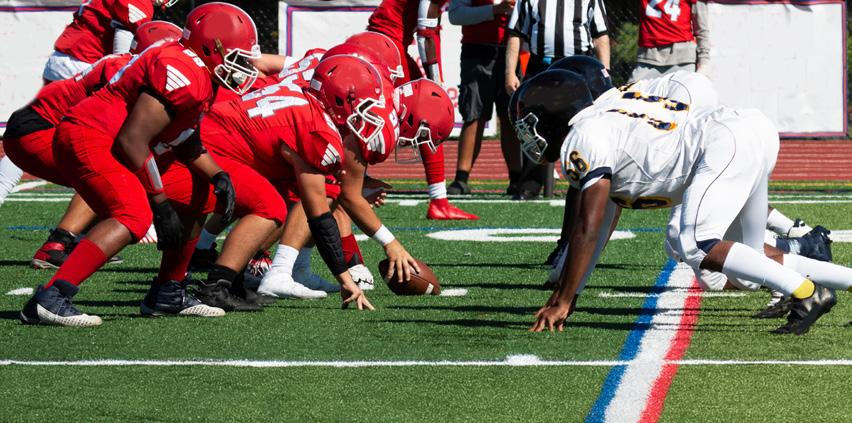
4 CEO NOW Congratulations to the Hall of Fame Class of 2025
6 ASSOCIATION NOW
Former NSGA Board Chairman Al Anderson and Former NBS President and Board Member Herb Biddle Pass Away; NSGA Promotes Jenny Shaffer and Hayley Fansler
10 RECOGNITION NOW
Introducing the Hall of Fame Class of 2025 of John Cardinal (Cardinal’s Sport Center), Chris Considine (Wilson Sporting Goods) and E.J. “Ned” Hamilton (Peter Glenn Ski & Sports)
15 CONFERENCE NOW
Breaking Down NIL for Small Businesses
18 CONFERENCE NOW
Steve Garvey Reflects on Leadership, Teamwork and Dreaming
22 RETAIL NOW
How the Merchandise Plan Drives the Retail Operation
26 NEWS NOW
Baker’s Sporting Goods Acquires Hobbs Sporting Goods; STAHLS’ Wins Printing Award; Chipply Adds to Sales Team; High School and Rules Updates
31 MEMBER SPOTLIGHT NOW
Give Me Five with Jim Butler, Butler Sporting Goods
8
NSGA’s latest Brand Ratings Report provides an updated look at Football Equipment and how team dealers and retailers view the manufacturers and brands.

15 22

One of the most poignant moments from the Pro Football Hall of Fame induction ceremony in early August was the enshrinement of Chicago Bears great Steve McMichael. McMichael, one of the stars of the fierce defense of the Bears’ 1985 Super Bowl championship team, has battled ALS (Lou Gehrig’s Disease) since 2021. He was unable to attend the ceremony in Canton, Ohio, but many of his former teammates, family members and friends went to McMichael’s home in suburban Chicago to celebrate the honor with him.
These honors are important to so many people such as the ones McMichael affected throughout his life. One of the great aspects of the annual Sporting Goods Industry Hall of Fame induction ceremony is to witness how much it means to family, friends and longtime colleagues who either attend the event, make the induction introduction or provide heartfelt perspective for a video of the inductee’s career highlights.
That’s why it’s always exciting to introduce the next group of Hall of Fame inductees. The Class of 2025 of John Cardinal, Chris Considine and E.J. “Ned” Hamilton influenced so many lives on their different paths to success in our industry.
John Cardinal, who passed away in 2013, became a revered figure in Texas athletics as a team dealer and retailer who started Cardinal’s Sports Center (now QuarterFour) in Lubbock. Cardinal never forgot his own tough family upbringing to make sure kids had the equipment and uniforms they needed to compete. And he did it in a way that commanded respect not only of the coaches and teams he supported but competitors such as 2019 Hall of Fame inductee Ronny Flowers of Athletic Supply in nearby Odessa.
Chris Considine spent 32 of his 40-plus years in the industry at Wilson Sporting Goods and has been the CEO of True Sports since 2020. Considine ascended to the position of President at Wilson in 2005 through his commitment to innovation for athletes at all levels. His commitment also extended to keeping manufacturing jobs in the United States and giving back to various charities and causes.
E.J. “Ned” Hamilton took a unique path to success in the ski and snowboard industry as he opened most of his Peter Glenn Ski & Sports stores (named after his son) in the warm weather climate of Florida. Hamilton successfully sold the sport to people who were a long way from any snow sports activity and ultimately helped build participation. Serving the entire industry has also been important to Hamilton as he was NSGA’s Board Chairman in 1972.
You can find out more about the important contributions of John Cardinal, Chris Considine and E.J. “Ned” Hamilton to the sporting goods industry in this issue of NSGA NOW and on our website, nsga.org. Make sure to check out the details for nominating deserving candidates for the Class of 2026 so we can continue to recognize and honor the legends of our industry. The NSGA website Hall of Fame page has all the criteria and biographies of all the inductees and visiting those pages may provide some inspiration for a nomination.
Please join me in congratulating Mr. Cardinal, Mr. Considine and Mr. Hamilton and everyone close to them on this wonderful honor!

CHAIRMAN OF THE BOARD
GORDON GEIGER
Geiger’s, Lakewood, OH
TREASURER/CHAIRMAN-ELECT
BOB FAWLEY
Capitol Varsity Sports, Oxford, OH
PAST CHAIRMAN
PAT DONNELLEY
Twin Falls, ID
BOARD OF DIRECTORS
KEVIN BEZANSON
Cleve’s Source for Sports, Halifax, Nova Scotia, Canada
TROY FREEMAN
Play It Again Sports, Minneapolis, MN
COLE JOHNSON
Johnson-Lambe Sporting Goods
Raleigh, NC
JUSTIN MILLER
Scholastic Sports Sales, Manlius, NY
MICK MONTGOMERY
Denver Athletic Supply, Englewood, CO
RON RUGAL
B&R Sporting Goods, Shelby Charter Township, MI
JOHN SCIPIO
SV Sports, Pottstown, PA
NSGA TEAM LEADERS
MATT CARLSON
President & CEO
HAYLEY FANSLER
Director, Business Development
MARTY MACIASZEK
Director, Team Dealer Division, Communications
JULIE PITTS
Director, Public Affairs and President, NSSRA
NICK RIGITANO
Director, Insights and Analysis
JENNIFER SHAFFER
Chief Financial Officer
Best regards,
MATT CARLSON PRESIDENT & CEO
NSGA NOW (ISSN 1045-2087) is published bi-monthly for members of the National Sporting Goods Association, 3041 Woodcreek Drive, Suite 210, Downers Grove, IL 60515. Phone: (847) 296-NSGA (6742).
Subscription price of $50 per year is included in membership fee. Non-member subscription information available from publisher. Periodical postage paid at Downers Grove, IL 60515 and additional mailing offices. POSTMASTER: Send address changes to NSGA NOW,® 3041 Woodcreek Drive, Suite 210, Downers Grove, IL 60515. © NSGA 2024 all rights reserved. Printed in the USA.


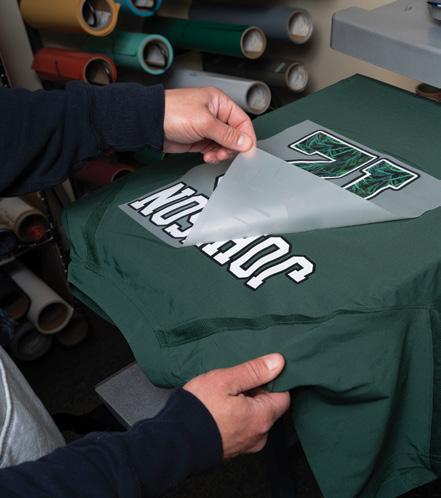
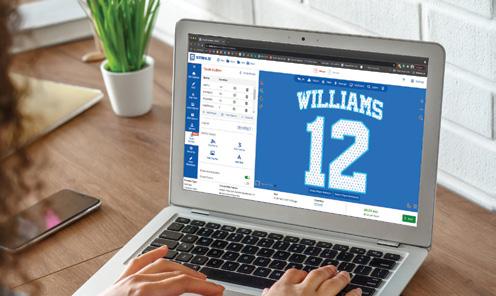
Al Anderson, who is the only Canadian to serve the National Sporting Goods Association (NSGA) as Board Chairman, passed away on July 2 at 92.
Anderson entered the sporting goods industry in 1955 when he started Athletic Equipment Sales in Saskatoon, Saskatchewan and it is now known as Al Anderson’s Source for Sports. Anderson was elected to the NSGA Board of Directors in 1971 and served as Board Chairman in 1974–75. He also served the Board as Vice Chairman/Chairman

Elect, Treasurer and Past Chairman.
In 2023, Anderson received the Saskatchewan Order of Merit, which celebrates the excellence and achievements of Saskatchewan citizens. Anderson volunteered in numerous organizations in Saskatoon.
NBS PRESIDENT AND NSGA BOARD MEMBER
Herb Biddle, the former President of the Nation’s Best Sports (NBS) buying group and a former member of the National Sporting Goods Association Board of Directors, passed away July 1 at age 82.
Biddle was part of the sporting goods industry for 27-plus years, according to a release from NBS, and served as NBS President from September 30, 1993 to

October 31, 2003. Biddle also served on the NSGA Board from 1996–2000.
Biddle started his sporting goods career as a salesman for The Shakespeare
JENNY SHAFFER, HAYLEY FANSLER
The National Sporting Goods Association (NSGA) made two promotions this summer with Jenny Shaffer to Chief Financial Officer and Hayley Fansler to Business Development Director.
Shaffer joined NSGA in July 2019 as Comptroller and served an internship with the association in the summer of 2011. She worked for the accounting firm of Plante Moran in Chicago from 2012–19 and her main responsibility was completing non-profit audits.
“Jenny has been a great addition to the NSGA team since she joined us and we are thrilled to have her serving the association in her expanded role as CFO,” said Matt Carlson, NSGA President & CEO. “Her experience in working with
non-profits and associations made for a seamless transition to NSGA and she will do a great job overseeing financial aspects of the association.”
Shaffer earned her Bachelor’s Degree in accounting from Saint Louis University in 2011 and her Master’s Degree in accounting from Northern Illinois University in 2012.
Fansler joined NSGA in March 2018 as Business Development Manager. She came to NSGA from the Emergency Nurses Association in the Chicago
His son Doug was born with cerebral palsy in 1960 so Anderson became committed to creating services and opportunities for people with disabilities. He developed Cosmo Golf, a partnership between Al Anderson’s Source for Sports and Cosmo Industries, where individuals with intellectual impairments produced golf clubs that were marketed and sold throughout North America.
Anderson is survived by four children and numerous grandchildren and great-grandchildren. Those he was predeceased by include his wife of 67 years, Joan, and his son Doug.
Company in Wisconsin and worked his way up to become vice president of the company in South Carolina. He was also president of Cannon (now S&K Products Company) in Michigan before going to NBS.
He is survived by his wife of 42 years, Bessanne, his sons Jim (Susan) Kiefer and Clay (Suz) Biddle, daughters Philion Biddle and Bridgette (Mike) Bumpas and seven grandchildren.
suburb of Des Plaines, Illinois as an accreditation specialist from 2013–18. Fansler also worked for the Texas Association of Realtors as a professional standards coordinator (2012–13) and with the Quincy (Illinois) Association of Realtors as an Executive Administrative Assistant (2010–12).
“Hayley has been a big part of the NSGA team and the annual NSGA Leadership Conference since she joined us and we are excited to have her serving the association in a larger leadership role as a director,” Carlson said. “She has done a tremendous job growing NSGA’s stable of year-round supporters and making sure the NSGA Leadership Conference is a first-class event for everyone who attends.”





BY NICK RIGITANO NSGA DIRECTOR OF INSIGHTS AND ANALYSIS
“What categories should I offer? What brands should I carry? How do other dealers view these brands? Are these perceptions becoming more positive or negative in recent years?”
These are some of the numerous decisions team dealers face regarding their business and vendor partners. When it comes to the tackle football segment, these decisions are made even more difficult because of the high level of market competition from the abundance of brands and products.
To give team dealers a better idea of the brands being carried and their ratings for certain business relationship categories for football equipment and apparel, the National Sporting Goods Association (NSGA) conducted the Team Dealer Trends: Brand Ratings Survey in the spring of 2024.
Whether an organization is an existing team dealer, a start-up dealer, or a retailer considering the addition of a team component, the resulting insights can aid in understanding the current landscape of the tackle football segment including competition levels serviced, brands carried for select categories and how those brands measure up against others based on certain attributes. This report can also be used by manufacturers to get a better idea of where they stand with their dealer customers.
The following is a snapshot of the information in the report:

This section provides an overview of tackle football sales among dealers for the most recent tackle football season in 2023. According to the report, 78 percent of dealer respondents reported an increase in their 2023 tackle football sales compared to the prior year. Among those, sales increased an average of 11 percent. Additional information in this section includes the median number of tackle football teams served by level and the percentage of tackle football sales attributed to each level, along with the percentage of total tackle football sales among respondents broken out by product category.
This portion of the report examines the percentage of dealers carrying a given brand for each of the nine product categories tracked. Featured product categories include footballs, helmets, protective pads, mouthguards, football gloves, football cleats/shoes, uniforms, performance apparel and field equipment.
The final section of the report explores the ratings given to 36 tackle football brands by their dealer customers based on six different business relationship categories of value for the price, timely delivery, product innovation, brand name recognition, sellthrough and customer service (toward the dealer).
An all-category average score is also given for each brand based on their average scores among the six categories. The category of customer service (toward the dealer) is new to the report this year and a preview of the top 5 rated brands is shown in Figure 1. SANMAR SPORTS received the top spot after dealers carrying the brand rated it most positively (4.71 avg.) Next in line were CHAMPRO (4.44) and PROLOOK (4.33). Rounding out the top five were Founder Sport Group (4.25) and Bison (4.16).
One of the benefits of conducting this study for multiple years is the ability to trend the results over time, allowing additional insights to be gleaned from the data. As an example, Figure 2 looks at some of the brands with the largest positive increases in overall feelings toward them since 2020 as rated by the dealer respondents. In this category, ratings for CHAMPRO, Founder Sport Group, Rawlings, Markwort, Spalding and Athletic Specialties are more positive than 2020.
The report is available to NSGA retailer and team dealer members as a complimentary benefit and can be downloaded at the Research Offerings section of the NSGA website. Other organizations interested in obtaining the report can contact Nick Rigitano, Director of Insights and Analysis, at nrigitano@nsga.org or (847) 296-6742, ext. 1080.


This report is available to you as a FREE member benefit. Go to the NSGA Research webpage at https://nsga.org/research/ to download this and previous brand ratings reports on sublimation, baseball and soft goods.
Want to find out how retailers and team dealers view your brand? Receiving the brand ratings reports is one of the benefits of being a NSGA supporter. To learn more contact Hayley Fansler, Business Development Director, at hfansler@nsga.org.
HOF Chairman and 2017 Inductee Larry Aasheim on why you should submit nominations:
“It’s important for us to be able to identify really great candidates.”

2010 Inductee Julie Nimmons:




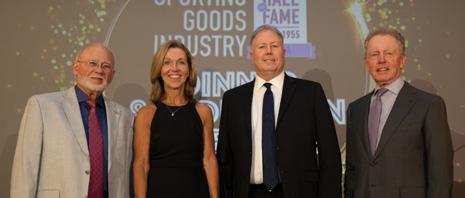
T2022 Inductee Bill Hunt:
“It’s a terrific personal honor but it’s really recognition for Champro as a company and I feel like our team has earned this.”
“It was an exclamation point for the time I spent at Schutt Sports.” 1 2 3
he Sporting Goods Industry Hall of Fame has recognized legendary people who made significant contributions to this industry since 1955. The Hall of Fame has now honored 188 men and women with the selection of the Class of 2025. On the following pages, you can learn more about the accomplishments of John Cardinal (Cardinal’s Sport Center), Chris Considine (Wilson Sporting Goods) and E.J. “Ned” Hamilton (Peter Glenn Ski & Sports).
NOMINATIONS ARE NOW OPEN FOR THE CLASS OF 2026! Members of every segment of the industry can submit the names of manufacturers, sporting goods retailers/ dealers and industry influencers they believe are worthy of election to the Hall of Fame for extraordinary contributions to the industry.



Learn more about the Hall of Famers as biographical information on every inductee is available at www.nsga.org/ hall-of-fame/.
If you have any questions about the Hall of Fame, contact Julie Pitts, Hall of Fame Secretary, at hof@nsga.org.
A large crowd listens to the acceptance speech of Ortholite’s Glenn Barrett at the 2024 Sporting Goods Industry Hall of Fame Dinner and Induction Ceremony.
2 The Sporting Goods Industry Hall of Fame Class of 2024, from left, John A. Solheim (representing the late Karsten Solheim of PING Golf), Cathy Pryor (Hibbett Sports), Mike Thompson (Rawlings) and Glenn Barrett (Ortholite).
3 From left, Mike Zlaket and Class of 2024 inductee Mike Thompson of Rawlings with Sporting Goods Industry Hall of Fame Chairman Larry Aasheim.

ohn N. “Johnny” Cardinal never forgot the important role sports played in his life.
Cardinal grew up as one of six children in a one-room farmhouse in Texas. The only way he could afford to get a college degree was through a football scholarship to West Texas State College. So, when Cardinal was running Cardinal’s Sport Center, headquartered in Lubbock Texas, he always found a way to help kids who did not have the means to get the equipment, shoes and support they needed to participate in sports.
That type of care Cardinal exhibited for his customers en route to building a successful retail and team dealer business led to his selection for induction with the Class of 2025 of the Sporting Goods Industry Hall of Fame.
“He built a successful dealership in a competitive market and always cared about his staff and salespeople,” said Roger Brackhan, the President of Lou’s Sporting Goods in Fremont, Nebraska. “His customers had a great loyalty that only comes from years of dedicated service to the schools and teams in his region. Not only was he an excellent businessman, he had that extra component of integrity and honesty that everyone knew and respected.”
Cardinal, who passed away in 2013 at age 87, went into education as a coach and principal after graduating from college. In 1959, he moved into the sporting goods industry as a
partner and road salesman with Buck’s Sporting Goods in Amarillo, Texas. He started building crucial relationships with coaches, athletic directors, school administrators and bookkeepers.
In 1968, Cardinal sold his stock in Buck’s and purchased the Sport Center in Lubbock, changing the name to Cardinal’s Sport Center. His son Tony and grandson John joined the family business that grew to four stores and a thriving team business.
“John Cardinal and Cardinal’s Sport Center in Lubbock was and is an institution in the sporting goods industry,” said Dave Salvi, the retired CEO of Sports Inc. “Cardinal’s was always the perfect example of what an independent team and retail sporting goods business should aspire to be.
“John was extremely influential, and he used that influence along with his leadership skills to help shape the sporting goods business not just in west Texas, but statewide.”
Cardinal was recognized for his contributions to Texas athletics with two high honors. He was inducted into the Texas High School Coaches Association’s Hall of Fame in 2004 and he was inducted into the Lubbock Independent School District Hall of Honor’s Class of 2017.
After he retired, Cardinal kept close relationships with the active and retired

coaches he worked with by holding weekly gatherings at Cardinal’s Coffee Shop so they could get together and tell stories and reminisce.
It underscored the respect Cardinal had, even from some of his biggest competitors such as Ronny Flowers of Athletic Supply in nearby Odessa in the Texas Panhandle. Flowers was inducted into the Sporting Goods Industry Hall of Fame in 2019.
“Even though we were considered competitors throughout the years, our companies had a healthy respect for each other,” Flowers said. “John ran a customer-first, family business in West Texas that steadily grew throughout the years.
“John and I maintained a great relationship throughout the years and I respected the fashion he serviced his customers and how he treated all his employees as family.”

he philosophy of “honor the past and lead to the future” has epitomized the 40-plus-years career of Chris Considine in the sporting goods industry.
Considine spent 32 of those years at Wilson Sporting Goods and started as a sales planning assistant in 1982. Wilson and Considine ascended to tremendous success together as he served in executive roles such as Vice President of Sales & Promotion, General Manager of Footwear, President of the Team Sports Division and President of the company from 2005–14.
Considine’s leadership skills are now helping True Sports, where he has been CEO since 2020. His impact throughout his career led to his selection for induction into the Sporting Goods Industry Hall of Fame with the Class of 2025.
Current Wilson CEO Joe Dudy worked with Considine for 15 years. Dudy said he is one of the beneficiaries of Considine’s ability to identify and develop young talent for team and individual success.
“Mr. Considine is a natural leader,” Dudy said. “He was able to get the best out of people through high standards, identifying talent and creating a team culture.
“Chris always believed that we were better as a team. He did everything to protect and encourage a team culture. He would always say as a team the good times are more fun and the hard times are easier to persevere.”
During Considine’s tenure at Wilson he led product innovations to accelerate
sports performances to help athletes succeed. He also developed strong partnerships with dealers, retailers, associations and organizations.
Wilson secured multiple technology patents under Considine’s leadership and launched popular products such as the Evolution and Solution basketballs, the GST football and a revitalized A2000 baseball glove franchise. He also led the strategic acquisitions of DeMarini and ATEC.
“Chris Considine’s impact extends far beyond the profit margins, retail door fronts and fields of play,” said Peter R. Davis, General Manager of Partnership Development for US Youth Soccer. “He has helped shape the sporting goods landscape from the recreational tennis court to the Final Four and on to the Super Bowl, leaving an enduring legacy that inspires future generations.”
Considine strengthened Wilson’s connection to star professional and collegiate athletes and coaches such as Michael Jordan, Tom Brady, Greg Maddux, Mike Krzyzewski, Roger Federer and Serena and Venus Williams. He has also been committed to keeping manufacturing jobs in the United States at the Wilson football factory in Ada, Ohio, the DeMarini factory in Hillsboro, Oregon and True Temper’s golf shaft factories in Mississippi and California.

Leo Kane was the NFL’s Senior Vice President for Consumer Products and worked with Considine during his tenure as Wilson’s President.
“The NFL and Wilson have arguably the longest relationship in sports and the iconic ‘Duke’ football from Wilson has been in all NFL games since the 1940s,” Kane said. “While other professional leagues changed their game balls, the NFL has never left Wilson. That track record belongs to many people but Chris always inserted himself into that negotiation to send the message of how important it was to Wilson.
“While Chris is a tremendous and dynamic business leader what always impressed me most was how he was a paternal figure to all at Wilson in an era of most corporations becoming cold and calloused.”
Considine has also led revenue growth at True Sports through product innovation and category expansion. True Temper golf shafts are the No. 1 brand on the PGA Tour, True Hockey is the fastest-growing hockey brand in the world and 44Pro custom ball gloves and bats are used by professional and collegiate players. He has also given back to the community through his work on charitable causes and service on the advisory board of the Positive Coaching Alliance.

elling snow skiing in the Sunshine State figured to be a tough proposition for E.J. “Ned” Hamilton.
Building a successful group of Peter Glenn Ski & Sports shops, named after his son, in the ski country of Vermont made perfect sense. When Hamilton moved to Florida in 1975 he was too young to retire so he opened a shop in Boca Raton where skiing evoked images of water and not snow.
But Hamilton made it work and sold and grew the sport along with his Peter Glenn stores. His contributions to the ski and snowboard industry earned Hamilton his selection for induction with the Sporting Goods Industry Hall of Fame Class of 2025.
“With his primary focus being the southeast, I can only imagine what the naysayers told him,” said Jon Rucker, the president of HEAD/Tyrolia Wintersports.
“Ned proved them all wrong. Not only has Peter Glenn been a multi-store, multi-decade commercial success with many of their locations far from any mountain, they continue to succeed in exposing countless individuals to skiing and snowboarding who otherwise might never see snow.”
Hamilton had already proved others wrong in 1958 when he owned a men’s clothing store and coached a women’s college ski team in Montpelier, Vermont. A local sporting goods store refused to carry ski products, claiming it was just a “fad,” but Hamilton saw the high demand for equipment and added clothing and accessories to his mix.
He quickly expanded to franchise stores and area shops named after Peter Glenn throughout Vermont. And he was ultimately able to accomplish the same success with multiple locations in Florida, Arizona, California and Alaska.
“We learned the hard way that there is a significant difference in the way you do snow sports retailing in Vermont vs. South Florida,” Hamilton said. “When we first came to Florida, we had to completely change our product mix, sell the sport before we could sell apparel and equipment, and help grow the ski clubs, which were so important to us during the early years.”
The Sports Authority approached Hamilton about Peter Glenn leasing the ski department within its Florida stores. It was extremely successful and expanded outside Florida and gave access to potential new skiers who might not normally frequent a specialty ski shop. This partnership ultimately led to the formation of the Snowsports Merchandising Corporation (SMC), a snow sports specialty buying group which is now part of Winter Sports Retailers (WSR).
Hamilton also created a group of retailers called the Consolidated Buying Associates (CBA), which was comprised of 20 retailers in 23 states and Washington, D.C. The stores brought a high level of customer service that

helped increase the chances of creating lifetime ski enthusiasts.
“Ned is a beloved member of our ski industry who values and encourages skiing as a lifestyle for families nationwide, promoting ski clubs from Florida and ski trips all over the United States and the world,” said Diane Boyer, the former chairperson of Snowsports Industries America (SIA). “Thanks to Ned, skiing has grown to be a multi-generational sport for families from Vermont to Florida.”
Peter Glenn has won numerous industry accolades and Hamilton credits his wife Carolyn as a pillar of support, along with his son, Peter, and daughter, Lori Underwood and her husband, Martin. Hamilton also expresses gratitude to his loyal staff of 64 years who have helped him build his successful business. Hamilton was a member of the National Sporting Goods Association Board of Directors and served as chairman in 1972. He also served on the Board of Directors of Snowsports Merchandising Corporation (SMC).
“Ned Hamilton is well-recognized as the epitome of the specialty retailer in the winter sports business,” said Gary Fleming, CEO of Winter Sports Retailers.


BY MARTY MACIASZEK NSGA DIRECTOR OF COMMUNICATIONS
When sports fans hear the acronym NIL they usually think big-bucks deals for big-time college athletes like Caitlin Clark or Caleb Williams.
The reality is the high-profile transactions of NIL, or Name, Image and Likeness, represent a small percentage of the overall landscape, according to NIL expert Bill Carter. Carter, the founder of Student-Athlete Insights, shared this reality during his NSGA 2024 Leadership Conference session, “Leveraging NIL for Business Expansion,” in Phoenix, Arizona. The message is smaller businesses such as local sporting goods retailers and team dealers can also be part of the NIL game.
“Ninety-five percent of deals are with local businesses, and small brands do deals that are mostly social media in nature with thousands of college student-athletes none of you have ever heard of,” Carter said. “Ninetyfive percent of them are from athletes who don’t play quarterback at LSU or Alabama. It’s everybody else we’re talking about. When you look at the median compensation it’s in the hundreds of dollars.”
The typical NIL deal pays a student-athlete about $200–$300 for a couple social media posts over a month, according to Carter. There are other options beyond straight cash, such as a coupon code, a commission based on sales or even the opportunity to do an internship with the company. Carter said the cost of an NIL test run isn’t prohibitive because the business is in complete control.
Continued on page 16
Continued from page 15
“You have to look at it as another employee,” Carter said. “A part-time employee or independent contractor you might ordinarily hire to work on your business or brand.
“Train your student-athletes on your brand. Think of them as independent contractors who you’re not going to have a daily connection with.”
Especially when the daily demands of the student-athlete are considered. Between attending classes, studying, practicing, training and competing in games or meets, the student-athlete has less than three hours of available time each week.
“The percentage of student athletes doing NIL is less than 25 percent,” Carter said, “and the percentage who want to do NIL is more than 50 percent.”
Due diligence on the background of the student-athlete as a potential NIL candidate is important for a business. Does he or she have good grades? Is he or she involved in the community and avoided any trouble that could put your business in a bad light?
It’s also important to know the competition. Are there other businesses in your marketplace working with college and/or high school athletes on an NIL relationship? Differentiating yourself is important.
“You don’t want to look similar to a competitor,” Carter said.
Social media is where 80 percent of NIL activity takes place, according to Carter. A lot of student-athletes are trying to build an apparel brand or run their own camps, clinics or private instruction.
“The No. 1 reason student-athletes as social media influencers are highly, highly effective is if you get two percent engagement, you’re happy,” Carter said. “Student-athletes are around two times that number.”
And it doesn’t have to be a student-athlete like LSU gymnast Livvy Dunne with
millions of followers across various platforms to make an impact. Most student-athletes are engaged with influencers who have less than 10,000 followers or fans on social media.
“Those types of student-athletes tend to have excellent credibility and connectivity with fans and followers so the engagement rights go up,” Carter said. “The most important thing to look for is the engagement rate.”
The social media marketing skills of the student-athlete are also important to NIL success.
“Can they take a decent picture and write decent copy?” Carter asked. “Can they stay on schedule and be a good communicator? If you’re going to bring them in your store, will they be engaging with your customers?”
And NIL could end up being a good deal if it keeps those customers coming back.
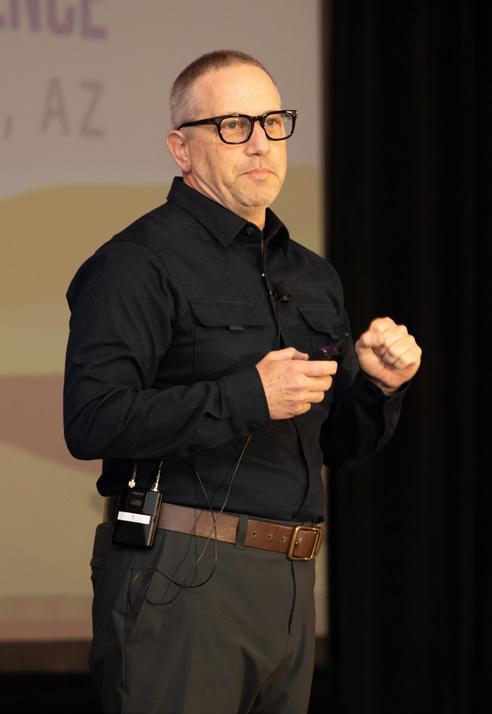
>> NIL expert Bill Carter had an engaging session, Leveraging NIL for Business Expansion.



>> Successful leadership was one of the big topics of baseball legend Steve Garvey’s closing keynote.
BY MARTY MACIASZEK NSGA DIRECTOR OF COMMUNICATIONS
Steve Garvey gained a rare view of leadership by playing for three Hall of Fame managers during the bulk of his illustrious 19-year big-league baseball career.
Garvey’s two managers with the Los Angeles Dodgers were Walter Alston and Tommy Lasorda and his manager with the San Diego Padres was Dick Williams. The trio combined for 5,210 victories and 8 World Series titles.
And all three were vastly different in their leadership approach as Garvey discussed during his closing keynote, “The Drive to Get After it Every Day,” at the NSGA 2024 Leadership Conference in Phoenix, Arizona.
“Three different personalities I was fortunate to learn from,” Garvey said. “Great teams have the quiet, the loud, the thinkers and the reactors. The manager and the leaders bring all these components and all these personalities together and get them in one direction working together.”
Garvey was a 10-time All-Star, four-time Rawlings Gold Glove winning first baseman and 1974 National League Most Valuable Player. He played in an NL-record 1,207 consecutive games from 1974–83.
Alston was his first manager and the one who stuck with Garvey as he struggled to find a regular position in the first five years of his big-league career. Garvey had very limited experience at first base but took on the challenge when asked by Alston and it turned out to be a game-changer.
“Quiet but always watching, always looking, always listening,” Garvey said of Alston. “When he said something to you, you knew he had thought this out and he was going to tell you what you needed to do, what was best for you and how you could best help the team.”
Alston retired in 1976 and was replaced by Lasorda, who had been part of the Dodgers’ organization for years and managed Garvey in the minor leagues. Lasorda was the opposite of Alston with a dynamic, larger-than-life persona.
“I said one time in an article (Lasorda) was the PT Barnum of baseball… and he said, ‘Garv, what do you mean I’m the PT Barnum of baseball?’” Garvey recalled. “I said, ‘It’s like a 3-ring circus and you’re in the middle of it. You’ve got the top hat and you’ve got the little whip and you’re whipping the pitchers and everyday players into shape.’ Tommy had a huge vocabulary and he was the outgoing version of Walter Alston.” Then Garvey went from the Dodgers to the Padres in 1983 and encountered Williams. Garvey and other star veterans like Hall of Fame pitcher Goose Gossage, Graig Nettles and Garry Templeton were utilized by Williams to impart wisdom to younger players.
“A fundamentalist. A strong guy and a tough guy,” Garvey said. “He was tough love, but he was a great X’s and O’s guy. He really understood the mechanisms of the game.”
Garvey would carry many of the leadership lessons into his post-playing career and his involvement in starting businesses and charities. He also understood the importance of finding the right talent and nurturing it as one of nine players from the 1968 Dodgers’ draft class who played at least eight years in the major leagues.
“It’s about developing teams. That team you have in business is a talented group of men and women,” Garvey said. “When they’re brought together and put in the right environment and with the right encouragement you are going to be successful.
“It’s about falling down, getting up and making progress. We keep trying, we keep getting up, we make adjustments. If you’re a manager, president, CEO, can you do this? Absolutely. It’s what life is all about.”
Garvey shared one of his most impactful moments as a 7-year-old living in Tampa, Florida where his mom was a fan of the Yankees and his dad was a fan of the Dodgers. His dad drove a Greyhound bus and had to pick up the Yankees for a spring training exhibition game.
Garvey, who recalled his first glove being a Rawlings’ “Heart of the Hide” that cost $9.95, didn’t hesitate when asked by his dad if he wanted to skip school that day. He shared the memories of meeting legends like Jackie Robinson and Roy Campanella, watching Mickey Mantle take batting practice and playing catch with Gil Hodges.
“I picked up a fresh Roy Campanella catcher’s glove and remember the smell,” Garvey said. “I get on the bus for the trip back, I’m 7 years old, and my dad said, ‘How was your day?’ I said, ‘It was the greatest day of my life.’
“It’s what America is all about and what you’re all about. You’re in an industry that creates memories, an industry where dreams start and you make them come true.
“We’re human beings. We fail. We succeed. But I say it all the time, reach for the moon and if you fall short, you’ll become a star.”

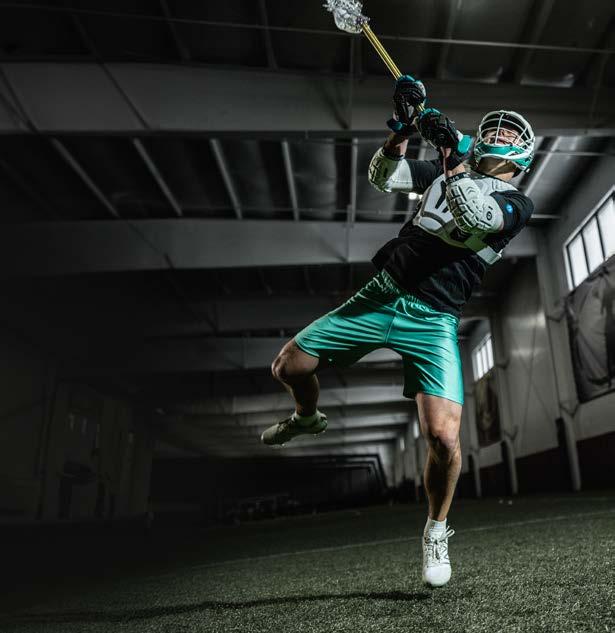




BY RITCHIE SAYNER ADVANCED RETAIL STRATEGIES
Let’s examine the engine that drives a retail store, the merchandise plan. An intelligently designed merchandise plan consists of the following:
• A sales forecast by month
• A markdown plan
• A projected first of month inventory plan at retail (current selling price)
• Planned receiving at cost and retail.
• A section devoted to merchandise-on-order
• An Open-To-Buy (OTB) shown at both cost AND retail
• Historical valuations for all the above for comparison purposes
Let’s look under the hood and take a closer look at each one of these important components, beginning with the sales forecast. This is the starting point for every merchandise plan. It does not emanate from the total company or store. That would be an
example of top-down planning as opposed to a bottom-up approach. To achieve a bottom-up approach, the sales planning must begin at classification level. Each store location must be planned separately.
Several considerations should be taken into account when planning sales. Certainly last year’s selling cycle should be considered along with any unique seasonal factors. What is the current trending of the class being planned? What have the IMU% (initial markup), MMU% (maintained markup), GMROI (gross margin return on investment) and turnover been historically?
Assuming you or your buyers have been to market lately, how does the merchandise look for next season? Are there any new, hot lines in the industry that might drive sales? Were sales last year driven by markdowns? Were sales
missed in any month last year due to insufficient inventory levels? The answers to these questions and others will help you fomulate the monthly sales forecast for the upcoming season or year.
Markdowns are planned because they are a necessary part of the retail business. There are several ways to plan markdowns. Some planners prefer to use a percentage of planned sales, while others might want to follow known historical patterns. Either way, the markdowns should be planned around a desired maintained markup figure to insure profitability.
A sales plan void of planned markdowns runs the risk of coming up short in inventory toward the end of a given season. Understandably, markdowns are considerably higher at traditional clearance times such as January and July, but can also run higher for regularly occurring promotions.
An understanding of how your POS system handles markdowns will be helpful here as some systems deal only with point-of-sale markdowns, while others have the capability of handling blanket markdowns also known as general price changes or permanent markdowns.
Inventories should be planned at the current sellling retail price and are shown as BOM (Beginning of Month) or FOM (First of Month); either is fine. Since the monthly beginning inventory levels are such a key component of any merchandise plan, it is vital that this figure be as accurate as possible. Desired inventory turnover is an integral part of the beginning inventory as are the stock-to-sales ratios.
For the sake of illustration, let’s assume we are planning a given class to turn 3 times. Our total planned sales divided by our planned turn will provide us with an “average” retail inventory. However that is one number and there are 12 months. So Stock-toSales ratios or number of months of supply, are used to provide FOM stock levels. In our example of a 3-time turn, the average S/S ratio is 4. This is calculated by dividing the planned turn into 12 months. The S/S ratio will most likely vary each month based on seasonality and selling patterns. The busier the month, the tighter or lower the planned S/S ratio.
Consideration must be given to the nuances of the user’s POS system to avoid stock valuations that are either over- or under-stated. If a certain POS system only recognizes point-of-sale markdowns, the FOM inventory levels will be overstated as long as it takes the reduced inventory to sell. This can be particlarly relavant during highly promotional time periods like season ending sales.
In faster-turning operations, this is less of an issue than slower-turning stores
as the reduced product is typically liquidated in a few weeks. If the POS system has the capability of handling permanent price changes, the markdown is “realized” or recorded when it is actually taken and the inventory valuation is adjusted accordingly.
Planned receiving at cost and retail becomes a math calculation once the topics already discussed have taken place. Since we are dealing with the retail system of inventory, the planned receiving at retail considers the FOM inventory from the current month minus the projected sales and planned markdowns. This difference is then compared to the planned FOM stock level of the next month to establish the planned retail receiving number.
The Merchandise-On-Order (MOO) is the next step in the process. The MOO is deducted from the receiving at retail or cost to yield the Open-To-Buy (OTB). This is why it is so important to have updated MOO figures. Without knowing how much is on order, you only have a sales, inventory and receiving plan, but no realistic OTB. It is a good business practice to record orders in the POS system immediately upon being placed so that all involved have complete transparency to the MOO. Maintaining the MOO also includes making certain “dead” orders or merchandise that has been canceled are removed from the open order status.
The Open-To-Buy (OTB) feature is the last calculation of the merchandise plan. OTB is merely planned receiving at either retail or cost minus the Merchandise-On-Order (MOO).
It should be obvious by now that a merchandise plan is so much more than
simply an OTB plan. If done correctly, it is also a cash flow and ROI plan incorporating properly timed deliveries on new goods, as well as markdowns on slow-moving products.
Like any engine, maintenance is the key to performance and longevity. Sales should be re-trended often during the month to provide the most realistic outcome. Markdowns may end up being higher or lower than plan and Inventory and on-order levels are also subject to change based on adjustments in delivery schedules, canceled orders or new orders placed.
Operating any retail operation without a merchandise plan would be like building a house without a blueprint or trying to drive a car without an engine. In either case, without a plan the results will not be what you had not hoped for.

Sayner has spent the past four decades helping independent retailers improve profitability. In addition to speaking to retail groups nationwide, Sayner is a regular contributor to retail industry publications. Prior to embarking on his retail consulting career, he was the general merchandise manager for an independent department store in the Midwest. Ritchie is a graduate of the University of WisconsinLaCrosse. He is also the author of the book, “Retail RevelationsStrategies for Improving Sales, Margins, and Turnover.” He can be reached though his website at www.advancedretailstrategies.com. @RitchieSayner



Introducing Richardson Performance, our first-ever collection of stock apparel designed to help your team hoist trophies and raise banners.
Featuring innovations like Stay-Dri moisture management, Max-Motion engineering, and premium 4-way stretch fabrics, each piece in this collection is crafted to ensure you’re not just breaking sweat; you’re breaking records.

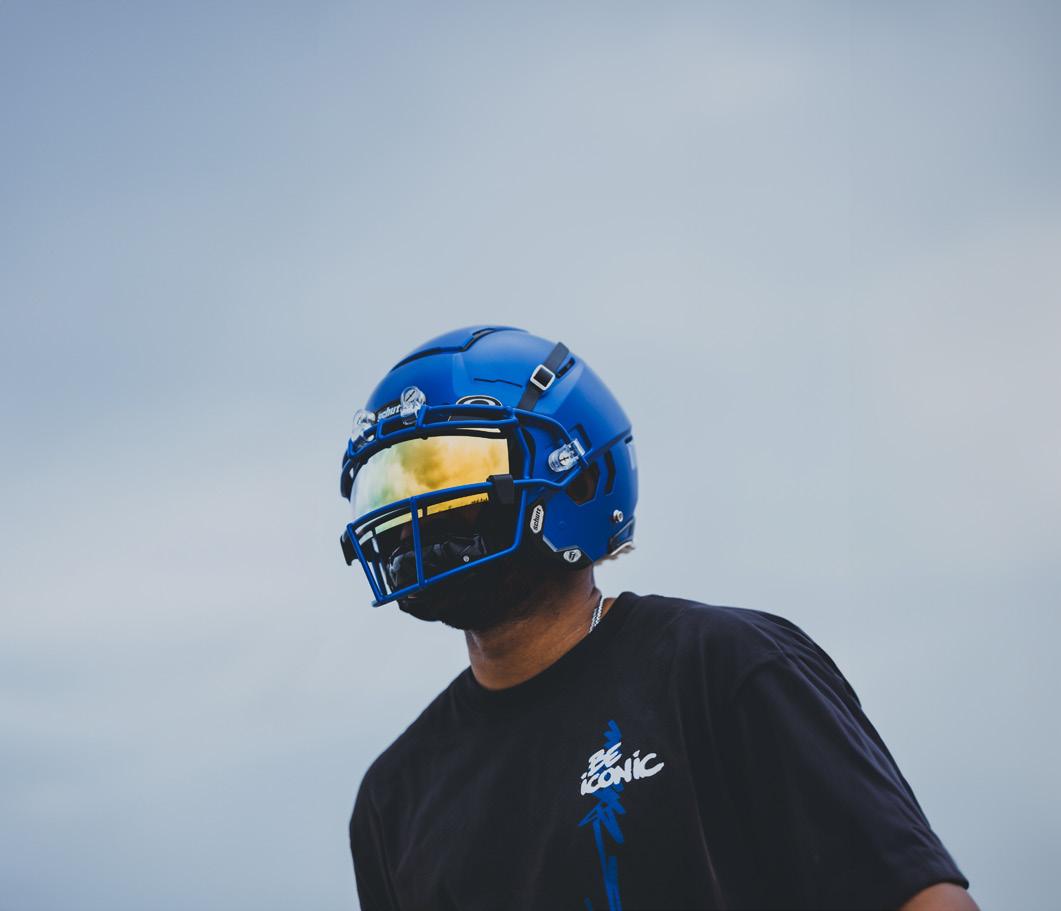


The BRC Sports Family of Brands, which includes Baker’s Sports, is acquiring Hobbs Sporting Goods, a team dealer in Dublin, Georgia. Hobbs will become a sister company to Baker’s.
Josh Baker, the owner of Baker’s Sports, and Frank Hobbs and Chuck Ross, the owners of Hobbs Sporting Goods, see this as an opportunity to take both companies to a higher level, according to a press release. Baker will become President & CEO, Hobbs will become Vice President of Purchasing and Ross will become Vice President of Operations for the state of Georgia.
“The Hobbs name has always stood for high quality and customer service,” Baker said. “Our plan is to expand the product offerings and capabilities while keeping customer service our No. 1 priority.”
Baker’s Sports, Inc., has been providing sports apparel and goods to youth leagues, schools, colleges, businesses and so much more since 1998. In 2011, Baker moved his entire operation under one roof and having the ability to screen print, embroider, heat press and sublimate items in one location has enabled the company to realize double-digit growth the past several years. Baker’s now serves more than 190 schools and colleges and numerous youth leagues and other businesses and organizations throughout the United States.
Hobbs Sporting Goods was established in 1968 by Billy Hobbs and has been recognized as one of the top team dealers in the southeast. In 1997, Billy’s
son Frank left teaching and coaching to work alongside his father in the family business. Billy handed down the reigns to the next generation in 1999 when Chuck Ross and Ellen Ross (daughter of Billy) joined Frank to grow their family business into what it is today.
Baker’s Sports is a NSGA member.

Chipply announced the additions of Meghan Brazzelle as the Senior Territory Manager and Patrick Tolivar as the Territory Sales Representative to its sales team.
Brazzelle brings a wealth of experience and a proven track record of success to her role with an extensive background of more than 18 years in the printwear industry. She will continue to excel in implementing cutting-edge strategies and optimizing processes while ensuring sustained growth and strengthening market presence. Brazzelle will keep growing sales in the designated territory while fostering relationships to excel in Chipply’s sales growth.
Tolivar had nine years of experience at Augusta Sportswear Brands, where he managed more than 600 accounts while strengthening relationships and driving sales growth. In his role, he will manage key accounts, develop new business opportunities, maintain relationships and achieve ambitious sales targets within the designated territory. Brazzelle and Tolivar will report to Grace Schettler, SVP of Sales for Chipply.
“We are thrilled to bring both industry experts to the ever-growing Chipply
sales team,” Schettler said. “With their deep understanding of the industry, it will make them an invaluable asset to our organization. Their dynamic approach to sales and commitment to excellence align perfectly with our mission to continue to deliver best-inclass service to our customers.”
Chipply is a member and supporter of the National Sporting Goods Association (NSGA) and Burghardt’s Sporting Goods is a member of NSGA.
S&S Activewear announced it reached an agreement to acquire alphabroder. The combined company will unite the branded apparel distributors to better serve customers and suppliers across the diversified corporate and consumer markets.
S&S Activewear and alphabroder have satisfied the regulatory review needed to complete the transaction. Upon completion of the transaction, which is expected to occur in late 2024, S&S Activewear and alphabroder will continue to go to market under their respective brands and existing distribution channels. S&S Activewear CEO Frank Myers and alphabroder CEO Dan Pantano will lead a disciplined, multiyear integration process designed to maintain the sales momentum for each business and position the combined company for long-term growth.
As part of the transaction, S&S Activewear intends to make significant investments in technology, the integration and expansion of its sales force, its supply chain and distribution capabilities and the employee experience to create an organization that delivers significant benefits to its customers and industry partners. The combined business will allow customers — and ultimately end-consumers — to benefit from faster, more accurate order fulfillment and increased inventory across in-demand categories, while
improved delivery and transportation logistics support significant savings in carbon emissions.
Since 2015, S&S Activewear has established twelve distribution centers, creating a nationwide coverage network to serve 99% of the United States, Canada and Puerto Rico within two days. As a combined business, S&S Activewear will focus on advancing its sustainability efforts, which has included the adoption of solar energy technology, high-efficiency LED lighting, water efficiency, and recycled packaging across the organization.
S&S Activewear and alphabroder are both supporters of the National Sporting Goods Association (NSGA).

STAHLS’ Hotronix® Dual Air Fusion IQ® with ProPlace IQ™ Projection System received a coveted Printing United Alliance 2024 Pinnacle Award for NonOutput Device Heat Press.
The annual Pinnacle Product Awards recognize products that improve or advance the printing industry with exceptional contributions in quality, capability and productivity. The NonOutput Device competition is an award for product improvements, specifically those that move the industry forward.
Paired with the Dual Air Fusion IQ®, the most efficient heat press in the industry, the ProPlace IQ™ projection system takes the power of precision printing, speedy production, and enhanced efficiency to the next level, resulting in a perfectly aligned design on any item, every time.
Open to all Printing United Alliance supplier members, the Pinnacle Product Award competition evaluates products
that will be available for sale in 2024. A highly qualified panel of judges across the printing industry evaluated the annual contest’s 160+ entries in more than 58 categories spanning analog, digital, output and non-output technologies.
STAHLS’ is a longtime member and supporter of NSGA.

Jamie Jeter, Outdoor Cap’s Head of Sales for Promotional Products, has been selected for this year’s Women in Business Best in Class Award given by the NWA Business Journal. Their primary objective was to update the way outstanding talent is spotlighted in Northwest Arkansas.
NWA Business Journal has established a distinct platform that exclusively recognizes the accomplishments of women in the workforce. The 10th annual Women in Business issue features 10 remarkable women business leaders from the Northwestern Arkansas region.
Jeter joined Outdoor Cap in May 2011 and has worked in numerous sales and product development roles. She has led the company’s promotional division since July 2022 and moved into her existing role in July 2023. She has been vital to enhancing the company’s customer experience by improving networks and how teams are paired with territories to give customers multiple ways to order. Jeter has a Bachelor’s degree in psychology from Abilene Christian University in Abilene, Texas. Outdoor Cap is a NSGA member.

Wilson Sporting Goods and the National Football League (NFL) announced the renewal of their partnership, naming Wilson again as the official football of the league. Since 1941, every point in the NFL has been scored with a Wilson® Football, making this one of the longest partnerships in sports history. As part of the multi-year extension, Wilson will unveil a brand-new football factory in Ohio, as well as become the official football of NFL Flag programs internationally, continuing the brands’ joint mission of growing the game across various demographics and countries. Every Wilson NFL game Football, dubbed “The Duke,” has been handcrafted at Wilson’s facilities in Ada, Ohio through a 20-step process. Wilson’s football factory is the world’s oldest factory dedicated to producing only game-ready genuine leather footballs. Wilson debuted its new and improved football factory, nearly doubling the capacity of the previous plant. This new space gives the true craftsmen and craftswomen in Ada — who make each football by hand — more space to continue their game-changing work, as well as the opportunity for Wilson to continue innovating, designing and offering the top product in sport.
The factory generates best-in-class products from youth to pro, making game footballs for the NFL season, including every Super Bowl and Pro Bowl, as well as youth, high school and college play. The new space includes a football museum that celebrates iconic Wilson and NFL moments, as well as a pop-up shop and manufacturing tours. Tours can be reserved online starting in July with a percentage of ticket proceeds being donated to youth sport groups in the greater area.
Continued on page 29
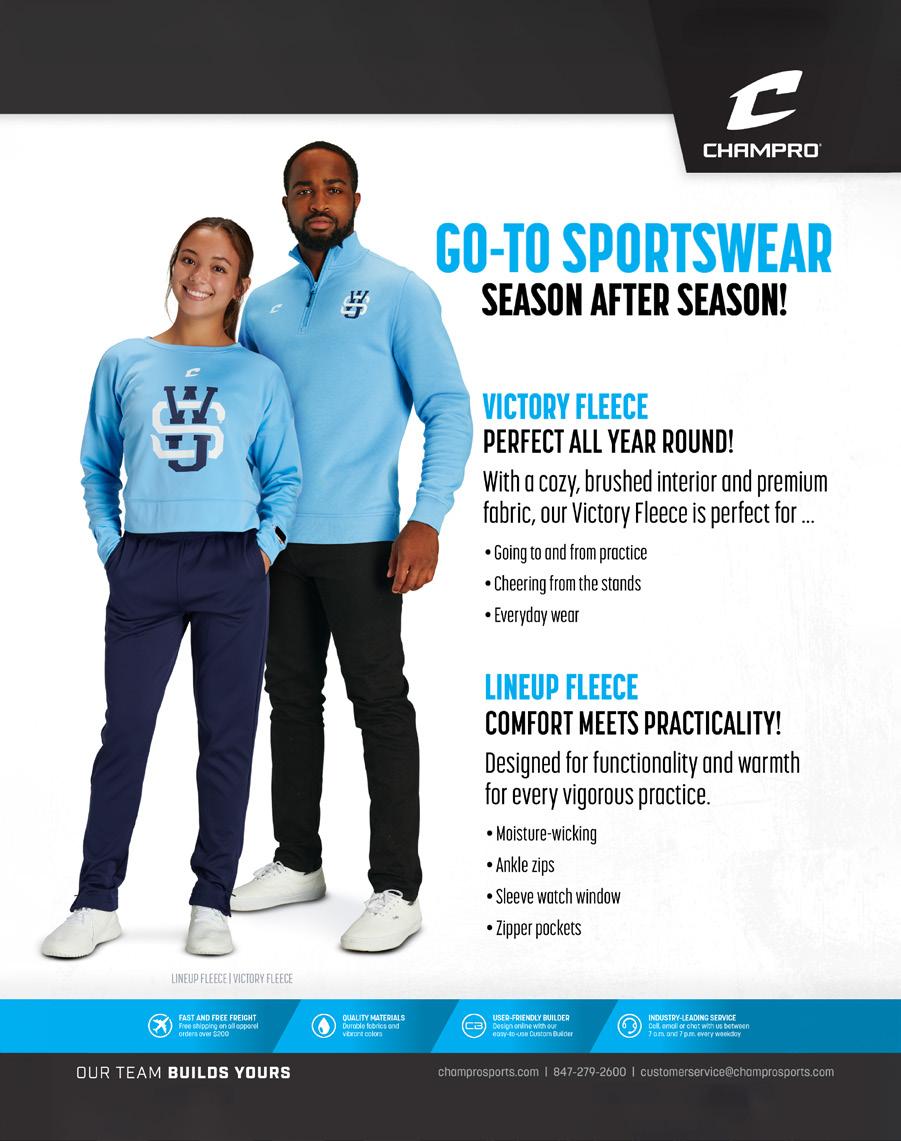
Continued from page 27
The upgraded facility is also home to product testing, ball customization and Wilson’s game-ready product break-in process.
Wilson will also become the official football of NFL Flag programming around the world. NFL Flag, the official flag football program of the NFL, brings the non-contact version of football to young athletes and is across 12 markets globally.
Wilson is a longtime member of the National Sporting Goods Association (NSGA).

Hibbett, Inc. announced the completion of the Company’s acquisition by JD Sports Fashion. Hibbett is now part of JD and will cease to be a stand-alone publicly traded company.
Mike Longo will continue as President and Chief Executive Officer of Hibbett and Jared Briskin will assume the role of Chief Operating Officer. Hibbett will maintain its corporate headquarters in Birmingham, Alabama.
Hibbett has 1,169 stores (including City Gear and Sports Additions) in 36 states as of May 4, 2024, according to the news release. The JD Group was founded in 1981 and had 3,300 stores worldwide as of May 4, 2024.
Hibbett is a longtime member of the National Sporting Goods Association.

JUNK Brands is excited to announce the launch of the new Infinity Headband.
This headband is 2 inches in the front and 1.25 inches in the back and double layered material, making the Infinity is a slimmer style option that offers a taper in the back to sit comfortably around the ear.
JUNK created this headband to fit versatile environments and uses, from working out to walking the dog. The Infinity headband sits comfortably over or under the ear and is smaller than the Big Bang Lite to accommodate different outfits and settings without scrunching. It is also made with our classic performance fabric, so you’re always ready to move forward.
The Infinity is a go-anywhere, do-anything fashion workout accessory. It will be great for men and women but we believe active women will love it most for low impact and casual wear. This headband still offers all the great attributes of JUNK Headbands. Sweat wicking, UPF 50+, 4-way stretch, breathable and non-slip for awesome performance no matter what you’re doing.
JUNK Brands is owned by Outdoor Cap, which is a NSGA member.
IAS Branding also has a new website at www.iasbranding.com.
JANELLE ANDERSON NEW CEO OF RIP-IT

RIP-IT, the leader in performance-driven innovations for female athletes, announced Janelle Anderson as its new CEO while introducing its new one-of-a-kind Women’s Future Court Volleyball Shoe. RIP-IT is the brand for female volleyball, softball and soccer athletes. It includes Tachikara, a legendary brand in volleyball equipment, and Ringor, the most comfortable and durable softball footwear.

Image Apparel Solutions has rebranded as IAS Branding. The company started in 1995 in the northwest suburbs of Chicago and Tim Kelliher is the company president. The new IAS Branding aligns better with its wide variety of capabilities in the custom branding industry, according to a news release from the company.
“We want to be our customers’ complete branding solution to elevate their organization,” the IAS Branding release said. “Even though our name is changing, you can still expect the same great level of customer service and attention to detail that has established us as a leader in the industry for nearly 30 years.”
“Janelle brings a wealth of experience and a fresh perspective that aligns perfectly with our vision for the future of RIP-IT,” said Matthew Polstein, cofounder of RIP-IT. “We are confident that under her leadership, we will continue to innovate and achieve great milestones.”
RIP-IT’s impactful mission is to elevate female athletes’ performance. “We believe in the profound yet simple concept that women and girls deserve gear that fits flawlessly, performs optimally, and mirrors the unique requirements of all female athletes,” said Anderson.
As CEO, Anderson will lead the brand to achieve its strategic goals and empower even more female athletes. As a former high school and collegiate athlete, she has a zeal for the female sports industry. Anderson knows the value of young women playing sports to build the self-confidence females need to reach their full potential.
Continued on page 30
Continued from page 29
Under Anderson’s leadership, RIP-IT is proud to introduce its new Women’s Future Court Volleyball Shoe powered by new-to-the-world volleyball innovations. The new shoe is designed with a more custom fit for women than other volleyball shoes currently on the market. It features a heel that eliminates slippage and a wider toe box for comfort, making it a comfortable and supportive choice tailored specifically for women players.
RIP-IT also hired Amy Craven as its first Chief Marketing Officer in July.
Learn more about the Women’s Future Court Volleyball Shoe and RIP-IT’s other volleyball, softball, and soccer equipment and apparel at www.ripit.com.
High school baseball players using non-wood bats will have greater flexibility in using substances to enhance their grip on the bat with a change that brings consistency to Rule 1-3-2 by the National Federation of State High School Associations (NFHS) for the 2025 season.
Rule 1-3-2c1 addresses allowable grips on non-wood bats and now includes clarification that resin, pine tar or another drying agent can be applied to the bat, not to exceed beyond 18 inches from the base of the knob. In addition to allowing players more grip control on their bats, it makes the standards the same as wood bats.
“For years, players using wood bats had the luxury of being allowed to use substances that ensure better grip,” said Elliot Hopkins, NFHS Director of Sports and liaison to the Baseball Rules Committee. “This rule change permits users of non-wood bats the same opportunity to protect others while maintaining a firm and solid grip of the baseball bat. Both styles
of bats can now enjoy the ability to improve their grip and hold while not interfering with the ball-striking area of the bat.”
High school softball coaches will be able to use electronic devices in the dugout for one-way communication to the catcher while the team is on defense beginning in 2025 after approval from the National Federation of State High School Associations (NFHS).
“This change is the result of analysis of current data, state association experimentation and a positive response from the membership,” said Sandy Searcy, NFHS director of sports and liaison to the Softball Rules Committee. “The committee has made these changes to support the use of emerging technology within the sport of softball. Being a permissive rule, the use of this one-way electronic communication will allow those who choose to embrace the technology an additional option to communicate with the catcher while on defense. It will also maintain the ability for those who prefer a more traditional approach to communicate using signals or a playbook/playcard to continue that approach.”
Accommodating one-way communication to the catcher brought new language to two different sections of the NFHS Softball Rules Book, starting with Rule 1-8-6. Devices such as earpieces, electronic bands and “smart” watches are now permitted as an EXCEPTION within the rule, provided the player does not utilize said device to return correspondence to the coaching staff. Prior to this change, team personnel could “record or transmit information pertaining to their players or team’s performance,” but could not communicate that information directly to players on the field during play.
Since both rules were updated for this change, the penalty from Rule 3-6-11 was added to Rule 1-8-6 as well, with violators subject to ejection unless the offense is ruled to be “of a minor nature.” This penalty has been in place for Rule 3-6-11 allowing the umpire to issue a warning if the offense is minor and then eject if the offense is repeated.
In addition to permitting the one-way communication devices, the updated version of Rule 3-6-11 regarding “Bench and Field Conduct” specifies that coaches are prohibited from using the device “to communicate with any other team member while on defense or any team member while on offense” and the coach cannot use the device “outside the dugout/bench area.”
The second rules alteration for the 2025 season occurred in Rule 9-3-2b, where the Scoring and Record Keeping details surrounding a player’s batting record were edited to align with the enforcement in Rule 8-6-11, which covers the runner’s actions and provides the direct penalty for those actions.

The National Junior College Athletic Association (NJCAA) announced a contract renewal with Spalding® as the official basketball of the association. The four-year agreement will continue through April 2028.
Spalding® initially partnered with the NJCAA in 2013 as the Official Basketball of the association. Member institutions from around the country will continue to utilize Spalding’s TF-1000 Legacy for all NJCAA region, district and national tournaments.
The NJCAA also announced it discontinued women’s lacrosse as a sponsored sport, beginning in 2024–25, because of a lack of participating schools.
My family moved to Cape Cod in 1973 and there was no local sporting goods store in the town. I grew up in a town that had two great shops and it was at that moment I knew I wanted to open my own shop. Over the next four years, while in college, I came up with a business plan, made some contacts and opened my shop in November 1977, five months after graduating from St. Michael’s College (Vermont).




Even though Cape Cod has an older population, athletics plays a major part in the community. Being a destination area, the Cape hosts many dif ferent sporting events, from Cape League Baseball, the annual Lobster Fest Hockey Tournament as well as a huge soccer tournament that brings teams from all over New England. There are seven hockey rinks on the Cape and Islands, and I’ve heard it is one of the highest concentration of rinks per capita in the Northeast.
When I first opened my shop I concentrated on retail sporting goods and athletic footwear. I stayed away from golf, tennis and hunting/ fishing. I left that up to the local specialty shops. Over the years we have expanded our team sales and focused on the major sports. Our strongest categories are hockey and baseball/softball. Lacrosse has been erratic from year to year, but still a good category for us in both retail and team. We also do a decent amount of field hockey sales.
Our location has allowed us to maintain a strong hockey presence. We are the only hockey shop on Cape Cod and the closest full-line hockey shop is about 50 miles away. We often have customers from the islands of Nantucket and Martha’s Vineyard send skates over for sharpening or repairs. In season, we seem to make daily trips to the local


The NSGA/HDA connection has been great for us. The camaraderie amongst the members is the biggest advantage. Being able to compare notes on the hottest trends and to be able to share inventories in a pinch is priceless. It’s important for the members to have someone in our corner fighting for us to get the best support from the vendors in this retail climate. With online sales and vendor direct sales, it’s the only way we can remain competitive. Hockey is becoming so specialized and any help we can get goes a long way.
